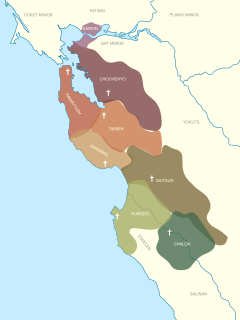Related Research Articles

Mission Nuestra Señora de la Soledad, known colloquially as the Soledad Mission or "Our Lady of Solitude" or Mission Soledad, is a Spanish mission located near the present-day town of Soledad, California. The mission was founded by the Franciscan order on October 9, 1791 to convert the Native Americans living in the area to Catholicism. It was the thirteenth of California's Spanish missions, and is named for Mary, Our Lady of Solitude. The town of Soledad is named for the mission.

The Ohlone, formerly known as Costanoans, are a Native American people of the Northern California coast. When Spanish explorers and missionaries arrived in the late 18th century, the Ohlone inhabited the area along the coast from San Francisco Bay through Monterey Bay to the lower Salinas Valley. At that time they spoke a variety of related languages. The Ohlone languages make up a sub-family of the Utian language family. Older proposals place Utian within the Penutian language phylum, while newer proposals group it as Yok-Utian.
San Carlos may refer to:

Asilomar State Beach, officially Asilomar State Beach and Conference Grounds State Park, is a state park unit of California, United States. It provides public access to rocky coast and dune habitat on the Monterey Peninsula. The property includes the Asilomar Conference Grounds, a conference center built by the YWCA in 1913 that is now a National Historic Landmark. The 107-acre (43 ha) site is located in Pacific Grove and offers overnight lodging and views of the forest, surf and sand.

The Rumsen language is one of eight Ohlone languages, historically spoken by the Rumsen people of Northern California. The Rumsen language was spoken from the Pajaro River to Point Sur, and on the lower courses of the Pajaro, as well as on the Salinas and Carmel Rivers, and the region of the present-day cities of Salinas, Monterey and Carmel.

The Esselen are a Native American people belonging to a linguistic group in the hypothetical Hokan language family, who are indigenous to the Santa Lucia Mountains of a region south of the Big Sur River in Big Sur, Monterey County, California. Prior to Spanish colonization, they lived seasonally on the coast and inland, surviving off the plentiful seafood during the summer and acorns and wildlife during the rest of the year.

Esselen was the language of the Esselen Nation, which aboriginally occupied the mountainous Central Coast of California, immediately south of Monterey. It was probably a language isolate, though has been included as a part of the hypothetical Hokan proposal.

The Chalon people are one of eight divisions of the Ohlone (Costanoan) people of Native Americans who lived in Northern California. Chalon is also the name of their spoken language, listed as one of the Ohlone languages of the Utian family. Recent work suggests that Chalon may be transitional between the northern and southern groups of Ohlone languages.

Mutsun is a Utian language that was spoken in Northern California. It was the primary language of a division of the Ohlone people living in the Mission San Juan Bautista area. The Amah Mutsun band is currently working to restore the use of the language, using a modern alphabet.
The mythology of the Ohlone (Costanoan) Native American people of Northern California include creation myths as well as other ancient narratives that contain elements of their spiritual and philosophical belief systems, and their conception of the world order. Their myths describe supernatural anthropomorphic beings with the names of regional birds and animals, notably the eagle, the Coyote who is humanity's ancestor and a trickster spirit, and a hummingbird.
Ohlone traditional narratives include myths, legends, tales, and oral histories preserved by the Ohlone (Costanoan) people of the central California coast.
Carmeleno may refer to:
Kakonkaruk is a former Rumsen settlement in Monterey County, California. It was located in the Big Sur area; its precise location is unknown.

The Ohlone languages, also known as Costanoan, are a small family of indigenous languages spoken by the Ohlone people. The pre-contact distribution of these languages ranged from the southern San Francisco Bay Area to northern Monterey County. Along with the Miwok languages, they are members of the Utian language family. The most recent work suggests that Ohlone, Miwok, and Yokuts are branches of a Yok-Utian language family.

Isabel Meadows was an Indigenous person belonging to the Rumsen Ohlone tribe. Born to a Native American mother and English father, she was the last fluent speaker of Rumsen Ohlone language. In her later life, she worked closely in Washington D.C. with a Smithsonian ethnologist for more than five years to document her culture and language.
The Chalon language is one of eight Ohlone languages, historically spoken by the Chalon people of Native Americans who lived in Northern California. Also called Soledad, it belongs to the one of the Ohlone languages of the Utian family. Recent work suggests that Chalon may be transitional between the northern and southern groups of Ohlone languages.

The Rumsen are one of eight groups of the Ohlone, an indigenous people of California.
Ramsen may refer to:
Rumsen, Rumsien, or San Carlos Costanoan may refer to:
References
- ↑ U.S. Geological Survey Geographic Names Information System: Tukutnut, California
- ↑ Milliken, Randall. 1987. Ethnohistory of the Rumsen. Papers in Northern California Anthropology No. 2. Salinas, CA: Coyote Press.
